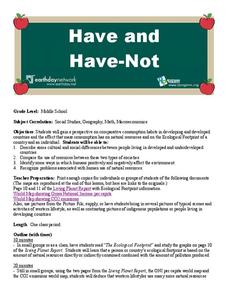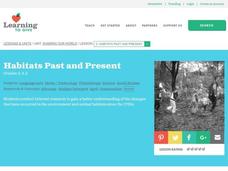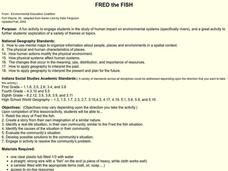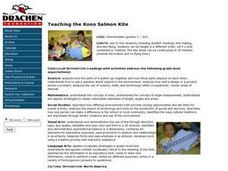Curated OER
Unit on Globalization and the Environment
Twelfth graders analyze issues affecting ecosystems. They examine the relationships between members of the international comunity. They also examine the concept of sustainable development.
Curated OER
Lotic Environment Lesson Plans
Learners create and conduct experiments on a "classroom river habitat." They manipulate the biotic and abiotic factors so that they are able to compare an artificially prepared river model to a naturally occurring lotic ecosystem.
Curated OER
How the Environment Effects our Feelings
First graders compare images and discuss their feelings created by an artist's work. They explore the correlation between experiencing feelings in art and literature and feelings caused by changes in weather.
Curated OER
Environment: The Haves and the Have Nots
Students examine consumption habits in developed and developing countries and determine their effects on natural resources. In groups, they assess graphs on the Living Planet Report and observe the connection between consumption and...
Curated OER
Food and Fiber: Helping the Environment and You
Fourth graders explore the many uses of corn-based products and the importance of water resources. They consider how biodegradable products help to keep water clean. They perform experiments to observe how corn pellets dissolve while...
Curated OER
The Fall and Rise of the White-tailed Deer Population: Conservation Success Story?
Pupils analyze the problems that have come along with the conservation movement and the fall and rise of the white tailed deer population. In this conservation lesson plan, students see how important the deer were to the Native Americans...
Curated OER
Solid Waste and Our Natural Resources: Utilizing the Story THE LORAX
Young scholars gain an introduction to our planet's solid waste problem and our personal responsibility in curbing and solving said problem through the use of Dr. Seuss' book, The Lorax. After hearing the book, class discussion follows.
Curated OER
Endangered Species 1: Why Are Species Endangered?
Young scholars are oriented to the plight of endangered species and to help them explain and gain perspective on human issues that continue to endanger species and threaten our global environment.
Curated OER
Habitats Past and Present
Students explore the changes in animal habitats. In this ecosystem lesson, students use the Internet to explore the changes in the environment since the 1700's. Students complete a Venn diagram to compare the differences in the animal...
Curated OER
But We Need More, Where Will It Come From?
Young scholars write a persuasive letter and create a poster about pollution and conservation. In this pollution and conservation lesson plan, students learn how humans are the number 1 cause of pollution.
Curated OER
Genetic Disorders with Cultural Roots: International Insects
Students recognize that certain populations have specific genetic disorders that could benefit or harm them in their environment, work out punnett square problems and infer offspring probabilities from results, and provide advantages and...
Curated OER
Who's Coming to Dinner?
Students identify the role predators/prey play in food chains, differentiate between food chains and webs, identify factors that affect the balance in food webs, and propose solutions to protect endangered species' environments and...
Curated OER
Environmental Action
Students investigate an environmental problem in order to find and propose possible solutions. The problem is real to add to the engagement of the lesson plan. This is found through conducting research and then brainstorming is done in...
Curated OER
Introduction to Biomes
Fifth graders use scientific skills and processes to recognize how living things depend on one another and on the environment for survival and the human use of natural resources impacts the environment. Explain how Earth's surface...
Curated OER
Food and You
Learners identify why humans are dependent on natural resources and the problems associated with their use and demonstrate how humans affect their environment. They also describe the different components and natural resources that go...
Curated OER
Lesson 1: Culture and Resource Use
Students research an aspect of Wabanaki culture that has persisted in Maine throughout the years. They write a conversation between a Wabanaki person and an English person that shows the different cultures and negotiates a solution to a...
Curated OER
The Cantankerous Pathogen
High schoolers explore what factors influence the spread of infectious diseases. They explain how human manipulation of the environment affects the transmission of diseases.
Curated OER
How We Impact the Earth
Students work in cooperative learning groups to create PowerPoint or KeyNote presentations on how humans impact the earth. This lesson can be accomplished in three different parts.
Curated OER
FRED the FISH
Young scholars engage in the study of the human impact on environmental systems (specifically rivers). This instructional activity enhances Students' exploration of a variety of themes or topics.
Curated OER
Cooperation Course
Students explain cooperation is vital in our relationship to the environment and with fellow human beings. They develop cooperation skills through group interaction.
Curated OER
Teaching the Kono Salmon Kite
Students complete several student readings involving kite making and kite flying. They analyze how the parts of a system go together and how these parts depend on each other. They comprehend how different environments both provide...
Curated OER
Disease and Epidemics
High schoolers explore how the study of diseases, epidemics and disease management offers opportunities for exploration of biological evolution, immune systems, interaction between humans and their environment, and interaction among...
Curated OER
EPA Pesticides Reduction
Students examine the effects of pesticides on the environment and bugs. They answer questions as an assessment.
Curated OER
URBAN WILDERNESS AND PARKS
Student examine the need for and the problems of wilderness areas which are located close to urban centers. They discuss their concept of wilderness, write down their perceptions and report to the class.

























